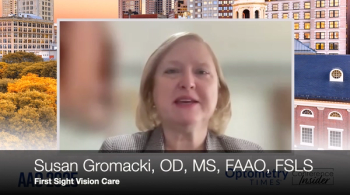
- July digital edition 2022
- Volume 14
- Issue 7
SCHs: mild trauma or something more sinister?
Case gives new perspective on subconjunctival hemorrhages
Individuals with conjunctivochalasis (CCh) tend to be the most symptomatic, difficult-to-treat patients with dry eye. CCh is an underdiagnosed, common condition characterized by loose, redundant, and nonedematous conjunctival folds typically located in the inferior bulbar conjunctiva.
The term (from the Greek chalasis, meaning "to slacken") was first used by Wendell Hughes, MD, in 1942.1 CCh, associated with subconjunctival hemorrhages (SCHs), can cause symptoms ranging from mild discomfort to tear outflow obstruction in the moderate stages and exposure keratopathy with subsequent visual loss in severe stages.2 Other characteristic signs include swollen puncta, anterior migration of the mucocutaneous junction—likely secondary to the delayed clearance of inflammatory proteins—and subconjunctival hemorrhage due to vessels in loose conjunctiva prone to rupture when blinking.3
Categorization
Generally, SCHs can be differentiated into 2 categories: traumatic vs spontaneous. CCh-related hemorrhages can be considered mild shearing force trauma.
Risk factors for spontaneous SCHs include hypertension and other systemic vascular disorders such as diabetes and hyperlipidemia. These diseases can cause blood vessels to become fragile and spontaneously rupture.
Hypertension has been shown to be a risk factor for SCH regardless of whether the blood pressure is controlled by medication. For patients in whom SCHs are recurrent or persistent, bleeding disorders, systemic and ocular malignancies, and drug adverse effects should be evaluated. Anticoagulation such as warfarin or heparin, nonsteroidal anti-inflammatory drugs (NSAIDs), such as aspirin, and P2Y12 inhibitors such as clopidogrel can also increase the risk of SCH. Other spontaneous causes include elevated venous pressures from coughing, vomiting, strenuous exercise/lifting, and Valsalva maneuvers.4
Patient case
A female patient, aged 42 years, recently presented with a 2-day history of a painless red eye. The patient reported that this was the second episode in the past 2 months.
Having examined the patient’s son in the past, I knew that this patient had ocular albinism. My patient’s diagnosis was SCH.
I asked the usual questions, hoping to elucidate the diagnostic association. To my surprise, my patient reported that she had Hermansky-Pudlak syndrome (HPS).
HPS is a rare multisystemic autosomal recessive disorder with many known subtypes. It is associated with oculocutaneous albinism, bleeding diathesis (an unusual susceptibility to hemorrhage due to platelet dysfunction), granulomatous colitis, and highly penetrant pulmonary fibrosis in some subtypes.
Genetic testing is recommended to determine the specific disease subtype in individuals with HPS because there are important phenotypic differences between subtypes that have critical implications for follow-up and prognosis.
Ocular albinism findings include reduced iris pigment with iris transillumination, reduced retinal pigment, foveal hypoplasia with a reduction in visual acuity (usually in the range of 20/50 to 20/400), and nystagmus. Hair color of patients with HPS ranges from white to brown, while skin color can range from white to olive and is usually a shade lighter than that of other family members.
The bleeding diathesis can result in variable bruising, epistaxis (nosebleed), gingival bleeding, postpartum hemorrhage, colonic bleeding, and prolonged bleeding with menses or from minor cuts and scratches or after tooth extraction, circumcision, and other surgeries.
The condition is most common in Puerto Rico, where an estimate suggests that 1 in 1800 to 1 in 16,000 newborns has HPS.5
I consider my patient’s recurrent SCH events as related to her HPS diagnosis. Avoidance of aspirin products and NSAIDs and protection from the sun is recommended for patients with HPS.
As eye care providers, we are competent in making the diagnosis of oculocutaneous albinism. It is critical for the provider to consider HPS when examining patients who have diagnoses of oculocutaneous albinism. Inquire about HPS-related symptoms because the systemic sequelae of this syndrome are associated with morbidity and mortality.
References
1. Yvon C, Patel BC, Malhotra R. Conjunctivochalasis. In: StatPearls. StatPearls Publishing; 2022. Updated November 27, 2021. Accessed May 20, 2022. https://www.ncbi.nlm.nih.gov/books/NBK576410/
2. Di Pascuale MA, Espana EM, Kawakita T, Tseng SCG. Clinical characteristics of conjunctivochalasis with or without aqueous tear deficiency. Br J Ophthalmol. 2004;88(3):388-392. doi:10.1136/bjo.2003.025460
3. Kittisupamongkol W. Blood pressure in subconjunctival hemorrhage. Ophthalmologica. 2010;224(5):332; author reply 332. doi:10.1159/000313835
4. Rare disease database: Hermansky Pudlak syndrome. National Organization for Rare Disorders. Accessed May 26, 2022. https://rarediseases.org/rare-diseases/hermansky-pudlak-syndrome/
5. Hughes WL. Conjunctivochalasis. Am J Ophthalmol.1942;25:48-51.
Articles in this issue
over 3 years ago
Don’t forget to flip the lids in keratoconusover 3 years ago
4 tips for pediatric contact lens fittingsover 3 years ago
Imaging technology helps in scanning for retinal diseasesover 3 years ago
Preparation is key to fighting dry eye while travelingNewsletter
Want more insights like this? Subscribe to Optometry Times and get clinical pearls and practice tips delivered straight to your inbox.



















































.png)


